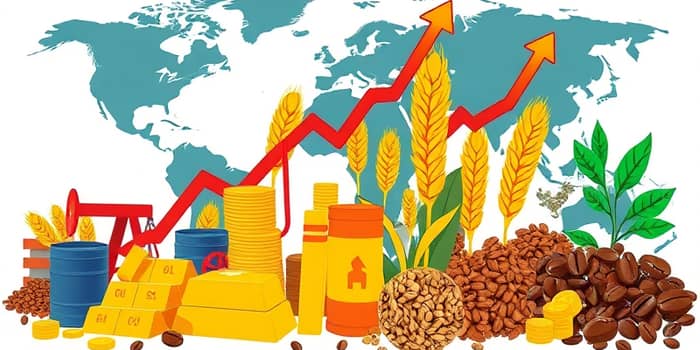Commodities investing offers a unique pathway to engage with the foundational elements of the global economy. This guide will equip you with the knowledge and confidence to begin your journey.
Understanding Commodities: Definition and Scope
At its core, a commodity is a basic raw material used to produce goods. These materials fall into key categories:
- Agricultural: corn, wheat, coffee, soybeans
- Energy: oil, natural gas, coal
- Metals: gold, silver, copper, platinum
- Livestock: pork, beef, cattle
Each category responds to distinct supply and demand forces. Agriculture is sensitive to weather, energy reflects geopolitical tensions, and metals align with industrial cycles. Recognizing these drivers is essential for any investor aspiring to navigate commodity markets.
Why Invest in Commodities?
Investing in commodities can bring several strategic advantages to your portfolio. First, commodities often exhibit low correlation with traditional assets like stocks and bonds. This means when equities falter, commodities can behave differently, offering a buffer against market downturns.
Second, commodities have historically served as a strong inflation hedge during periods of uncertainty. Prices for raw materials tend to rise when the purchasing power of currency declines, preserving real value.
Finally, commodities provide a direct way to benefit from supply shifts and demand trends. Whether you anticipate rising oil demand or foresee a grain shortage, commodities investing lets you align capital with your market outlook.
Main Ways to Invest in Commodities
As a beginner, you have multiple investment vehicles to choose from. Each carries its own risk profile, costs, and practical considerations.
- Futures Contracts: Agreements to buy or sell a commodity at a set price on a future date. Futures are highly speculative and leverage-driven, requiring substantial margin deposits.
- Physical Commodities: Direct purchase of goods such as gold bullion or silver coins. While tangible, this method entails storage costs and logistical challenges.
- Commodity Stocks: Shares of companies that produce or process commodities. Your exposure ties both to the commodity price and the company’s operational execution.
- ETFs and Mutual Funds: Pooled instruments offering diversified exposure across commodities via physical holdings, futures, or equities. These are beginner-friendly with lower capital requirements.
- Contracts for Difference (CFDs): Instruments enabling you to speculate on price movements without owning the underlying asset. CFDs allow both long and short positions but come with counterparty risk.
Getting Started: Steps to Begin Your Journey
Taking the first step in commodities investing can feel daunting. By breaking the process into clear actions, you’ll gain confidence quickly.
1. Open a brokerage account that supports commodities or related instruments. You will provide personal details and investment experience information to assess suitability.
2. Determine which vehicle aligns with your risk tolerance and capital. If you seek simplicity, an ETF or mutual fund may be ideal. For more active strategies, futures or CFDs could be appropriate once you build expertise.
3. Conduct market analysis. Dive into fundamental factors—crop reports, energy inventories, mining output—alongside technical charts to time your entry and exit points precisely.
4. Begin with small allocations. Starting conservatively in a volatile market protects your capital and allows you to learn from real trading scenarios.
Factors Influencing Commodity Prices
Commodity markets react to a blend of global forces. Understanding these dynamics is crucial for anticipating price movements.
Global Supply and Demand: Weather events, geopolitical crises, or unexpected shifts in consumer behavior can abruptly alter supply-demand balances.
Economic Indicators: Interest rates, inflation statistics, and GDP projections often sway commodity prices as they influence cost of carry and demand outlooks.
Geopolitical Risks: Conflicts, sanctions, and trade disputes can disrupt production and transport, creating supply shocks.
Seasonality and Production Cycles: Harvest times affect agricultural yields, while mining expansions can take years to influence metal output.
Finally, technological and regulatory changes can reshape energy markets through the adoption of renewables or new extraction methods in the oil and gas sector.
Managing Risk and Considerations
Despite their appeal, commodities come with significant risks. Prices can swing by double-digit percentages within weeks, and leveraged positions can magnify losses.
When holding physical commodities, you must account for insurance, storage, and security. Futures contracts require margin maintenance, and a sharp market move can trigger margin calls, forcing you to deposit extra funds or liquidate your position at a loss.
Moreover, trading complex instruments like CFDs demands a thorough grasp of contract terms and counterparty arrangements. Always review fee schedules, rollover costs, and liquidity considerations before committing substantial capital.
Practical Tips for Beginners
- Start with modest positions to gauge market behavior without overextending your capital.
- Consider broad-based commodity ETFs or mutual funds to obtain exposure across sectors.
- Research each market’s unique drivers—weather patterns for agriculture, OPEC decisions for oil, and industrial demand for metals.
- Diversify within your commodity portfolio; avoid concentrating all resources in a single sector.
Patience and ongoing learning are key. Markets evolve, and what works in one cycle may underperform in another. Embrace demo accounts to practice strategies and refine your approach before increasing live exposure.
Educational Resources and Further Reading
Building expertise requires continual education. Seek out reputable sources that offer both theoretical frameworks and real-world insights.
- Brokerage demo accounts to simulate trading conditions risk-free.
- Industry reports from government agencies and international organizations.
- Books on futures trading, commodity market structures, and technical analysis.
- Online courses and webinars offered by established trading platforms.
By immersing yourself in both academic research and practical tutorials, you will develop a nuanced understanding of each commodity’s behavior and the broader market context.
Summary Table of Commodity Categories
Commodities investing may appear complex at first glance, but by following systematic steps, managing risk prudently, and investing in your education, you can unlock the potential benefits of these vital markets. Embrace the journey with curiosity and discipline, and over time, you will gain both confidence and competence in navigating the dynamic world of commodities.
References
- https://www.investopedia.com/how-to-invest-in-commodities-7480946
- https://www.nerdwallet.com/article/investing/commodity
- https://smallexchange.com/commodity-trading-for-beginners
- https://www.etoro.com/trading/a-beginners-guide-to-commodity-trading/
- https://www.thearmchairtrader.com/markets/commodities/
- https://www.businessinsider.com/personal-finance/investing/what-are-commodities
- https://www.investor.gov/additional-resources/general-resources/publications-research/info-sheets/beginners-guide-asset
- https://www.sofi.com/learn/content/commodities-trading/










